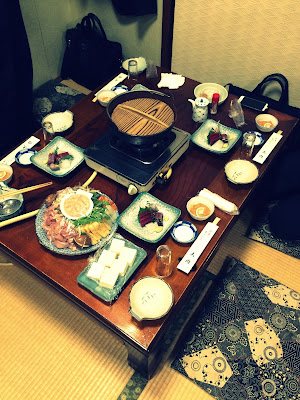Only in Japan would a nation obsess about the ballerina like
grace of round, pale, flabby men dressed in diaper thongs. I had the opportunity
to attend a wonderful afternoon of sumo with some of my local customers who had
never attended a tournament, but were avid followers of the sport and taught me
to appreciate the art of sumo.
A roof resembling a Shinto shrine suspended over the dohyō (ring)
The original sumo wrestlers were likely samurais or ronins looking for additional income opportunities. The current format dates back to the mid 1600s. This sport is
heavily weighted (no pun intended) in tradition and ceremony. While a typical match will only last about 8-15
seconds, the pageantry to get there can take over five minutes. The spectacle reminded this observer of a chauvinistic
male animal mating ritual to woo the opposite sex crossed with the New Zealand All Blacks Haka dance. This ritual has all of the key dramatic features including intimidation, throwing
of salt, multiple squats, occasional towel break and an interesting costumed referee all culminating in a short burst of belly rubbing and hugging.
I was very fortunate to have Japanese guests with me to explain
the sport, backgrounds of the fighters and all of the things that make this
sport so unique and exciting. There is
way too much to explain and one can only truly understand if you witness this,
but I will do my best. There are six tournaments
a year (three in Tokyo, one in Osaka, Nagoya and Fukuoka) and each tournament is 15
days. Top division wrestlers will have
one match a day and each day they will be ranked and matched based on their previous
day’s performance. There are no weight
classes, handicaps or restrictions - it is mano y mano and the winner either
pushes the opponent outside of the ring or he falls over. The initial impact from a sumo wrestler is
said to be the equivalent to being hit by a car going 35 miles per hour.
While weight is not the primary characteristic of a winner,
many of the wrestlers are over 400 pounds.
The training stables help beef up the boys through a diet
of Chankonabe which is chicken, fish, beef, tofu,
vegetables or anything deemed remotely useful in clogging the arteries which
are thrown in a broth and stewed in all their caloric splendor. The wrestlers are also encouraged to drink
beer and take naps immediately after eating.
I was lucky enough to try Chankonabe, but I would prefer a steak.
I hope that you can try to make it to one of these amazing cultural
events to witness the strength and beauty of 400+ pound ballerinas performing their
rituals and wrestling.
Until then,
rhs and Amy




No comments:
Post a Comment